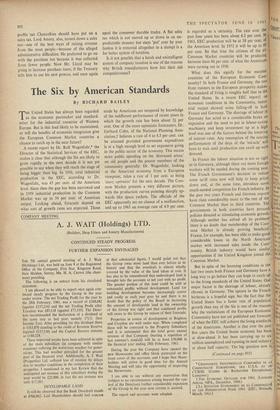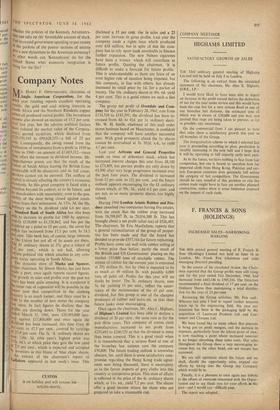The Six by American Standards
By RICHARD BAILEY THE United States has always been regarded as the economic pacemaker and standard- setter for the industrial countries of Western Europe. But is this lead likely to be maintained, or will the benefits of economic integration give the European Common Market countries a chance to catch up in the near future?
A recent report by Dr. Rolf Wagenfuhr,* the Director of the Statistical Services of the EEC, makes it clear that although the Six are likely to grow rapidly in the next decade it is not yet possible to say when they will reach the stage of being bigger than big. In 1956, total industrial production in the EEC, according to Dr. Wagenfuhr, was 45 per cent, of the American level. Since then the gap has been narrowed and in 1959 industrial production in the Common Market was up to 54 per cent. of American output. Looking ahead, forecasts depend on what sort of growth rates are expected. Those made by Americans are tempered by knowledge of the indifferent performance of recent years in which the growth rate has been about 21 per cent. One of the more optimistic forecasters, Dr. Gerhard Colm, of the National Planning Asso- ciation,t believes a rate of 4 to 4.5 per cent. can be attained provided government expenditure is at a high enough level to set expansion going in the public sector of the economy. This means more public spending on the 'distressed areas,' on old people and the poorer members of the community generally. Dr. Wagenfuhr, looking at the American economy from a European viewpoint, takes a rate of 3 per cent, as being `assez optimists' for the next decade. The Com- mon Market presents a very different picture, with the production curves pointing sharply up- wards like space rockets. The officials of the EEC apparently see no chance of a malfunction, and up to 1965 an average rate of 4.9 per cent. is regarded as a certainty. The rate over the past four years has been about 6.2 per cent. In 1965, EEC production will be at 58 per cent. of the American level. In 1972 it will be up to 60 per cent. By that time the citizens of the six Common Market countries will be producing between them 86 per cent. of what the Americans were turning out in 1956.
What does this signify for the membe countries of the European Economic Corn• munity? In both France and Germany, the two front runners in the European prosperity stakes, the standard of living is roughly half that in the United States. In a recent EEC reportt oo economic conditions in the Community, indus trial output showed some falling-off in both France and Germany. The shortage of labour in Germany has acted as a considerable brake on expansion and the need to put in labour-saving machinery and keep investment up at a high level was one of the factors behind the lowering of interest rates. Any resumption of the soaring performances of the days of the 'miracle' will have to wait until production can catch up with demand.
In France the labour situation is not so tight as in Germany, although there too more foreign workers will be needed during the coming year. The French Government's decision to reduce some tariff rates now will help to keep prices down and, at the same time, introduce some much-needed competition for French industry. In the past two years French and German exports have risen considerably more to 'the rest of the Common Market than to third countries. The governments in both countries have pursued policies directed at stimulating economic growth. Although neither has solved all its problems there is no doubt that membership of the Com- mon Market is already proving beneficial. France, for example, has been able to make good considerable losses in the North American market with increased sales inside the Con - munity. British industry would have similar opportunities if the United Kingdom joined the Common Market.
But in spite of the booming conditions in the last two years both France and Germany have a long way to go before they can hope to catch up to the living standards of the United States. One major factor is the shortage of labour, already chronic in Germany. The upturn in the French birthrate is a hopeful sign, but the fact that the United States has a faster rate of populatio44 growth than any of the Six is one of the reasons.
why the statisticians of the European Economic Community have not yet published any forecasts of when the EEC will achieve the living standards of the Americans. Another is that over the past five years the United States economy has been at slow-ahead. It has been carrying up to six million unemployed and running its steel industry at about half capacity. The big question now
(Continued on page 895)
if
* CROISSANCES INDUSTRIELLES COMPARIES DE LA COMMUNAUTII EUROPtENNE, DES U.S.A. ET DS" L'URSS. (Centre de Recherches Europdennes,' Lausanne.) t THE ECONOMIC OUTLOOK FOR 1961. (LOOKING $ ANFAD, NPA., December, 1960.) ° LA SITUATION ECONOMIQUE DE LA•COMMUNAUT 11 en ET LES PERSPECTIVES POUR 1961. (EEC, Brussels, pc March, 1961.)
.'hether the policies of the Kennedy Administra- Ilun can take up thi, formidable amount of slack. Fan increased government spending to put money In the pockets of the poorer sections of society give a new dynamism to the American economy? in other words can 'Kennedyism' do for the United States what economic integration is doing for the Six?











































 Previous page
Previous page